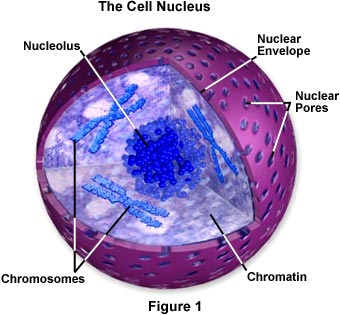NUCLEUS (Dynamic Centre, Master Organelle, Cell
brain)
It is a spherical ball like structure which controls and co-ordinates the life activities of a cell hence it is said to be
important organelle of the cell.
·
This was first discovered by A V Leeuwenhoek in RBC of fishes in 1700 later
by Robert Brown in orchid cell in 1831
·
Single nucleus found in every cell, in the same
way two nuclei found in ascomycetes and basidomycetes fungi
and in tapetal cells
·
In algae (Vaucheria),
fungi (Rhizopus) multinucleate
condition is found.
·
In Meristematic cells, nucleus is present in the
centre where as in mature cells at
the periphery. In Acetabularia, at the basal part of the
stalk, in sieve tubes it is absent
·
Cells which are fused in some cells (fibres of
animals) and (latex of higher plants) become multinucleate.
Morphology
·
Generally only one nucleus is present in a cell
but in some it will be binucleate or multinucleate.
·
Size :
variable.
·
Position:
Determined by physical factors like
·
Surface
tension: The tension of the surface film of a liquid caused by the
attraction of particles in the surface layer by the bulk of liquid which bends
to minimize surface area.
·
Relative
density of cytoplasm: Ratio of density of something to the density of a
standard.
·
Shape:
Depends on the cell shape and function
·
Round : Cuboidal
·
Oval :
Cylindrical
·
Disc : Squamous
·
Lobe : Insects
·
Lens : Plant cells
·
Kidney : Paramecium
·
Horse shoe : Vorticella
·
Bead : Slender
·
Branch : Ephelota
Hurtwing said about the Nucleoplasmic
ratio (NP) index which shows the relationship between volume of cytoplasm
and nucleus
Structure of Nucleus
Nuclear membrane/Nuclear
envelop/Nucleolemma
·
In Eukaryotes, it is bounded by a double
membrane envelop in which two unit membranes are separated by a perinuclear space (10-15mm width).
·
Outer membrane is continuous with unit membrane
of Golgi complex, Endoplasmic reticulum and chromatin.
·
Thickness: 75A⁰
and lipoprotein in nature.
·
It is porous and establishes a connection
between nucleoplasm and cytoplasm with diameter 700-760A⁰. Each pore possesses a ring or cylinder shaped annulus hence it named as Pore Complex by Smith and Watson which
acts a dynamic barrier.
Nucleoplasm/Karyoplasm
·
It is homogenous,
semisolid substance filled inside the nucleus composed of glycoproteins, ribonucleoproteins, hydrolyzing
enzymes, DNA, RNA polymerases and chromatin
material.
·
In this network of fibres present .
Chromatin material
·
It was first observed by Hofmeister (1849).
·
It is a combination
of DNA and proteins that make up the contents of the nucleus.
·
Deeply
stained network like structure found in nucleoplasm i.e., chromatin reticulum associates with histone proteins appearing as a fine threads.
·
During
cell division, chromatin transforms
into thick rod shaped structures known as chromosomes.
·
Chromatin
is deeply stained at some areas which looks like dark spherical bodies false nucleoli/karyosomes
·
Euchromatin is a packed form of DNA, RNA and proteins.
·
Heterochromatin is tightly packed form of DNA.

Nucleus
Nucleolus/Plasmosome
·
It was reported by Fontana (1781).
·
It is a non-membrane bound structure composed of
proteins and nucleic acids.
·
In every nucleus, one too many spherical deeply
stained bodies known as nucleoli are
found.
·
Central part is fibrillar (5-10nm), and peripheral is granular (10-20nm)
·
It develops from secondary constriction of a chromosome
known as nucleolar organizer.
·
It acts as a seat for the production of ribosomes.
·
During nuclear
division it disappears and reappears at cytokinesis phase.
Functions
·
It plays an important role in heredity.
·
It controls
and regulates the functions of the
entire cell.
·
It helps in
reproduction of unicellular
organisms.
| 




